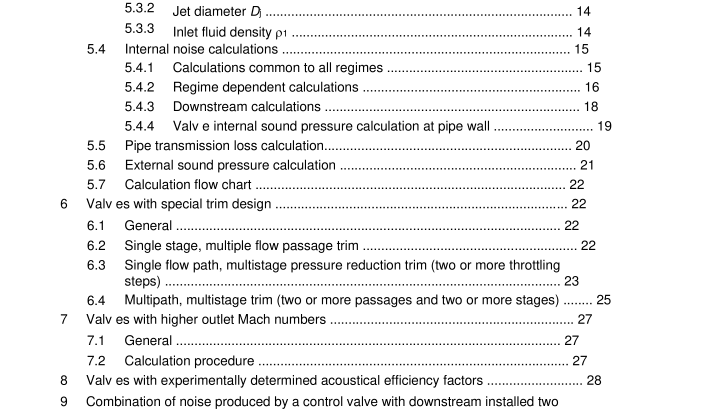IEC 60534-8-3:2010 pdf download – Industrial-process control valves – Part 8-3: Noise considerations – Control valve aerodynamic noise prediction method
1 Scope
This part of IEC 60534 establishes a theoretical method to predict the external sound- pressure lev el generated in a control v alv e and within adjacent pipe expanders by the flow of compressible fluids.
This method considers only single-phase dry gases and vapours and is based on the perfect gas laws. This standard addresses only the noise generated by aerodynamic processes in v alv es and in the connected piping. It does not consider any noise generated by reflections from external surfaces or internally by pipe fittings, mechanical v ibrations, unstable flow patterns and other unpredictable behav iour. It is assumed that the downstream piping is straight for a length of at least 2 m from the point where the noise measurement is made. This method is valid only f or steel and steel alloy pipes (see Equations (21) and (23) in 5.5).
The method is applicable to the following single-stage v alv es: globe (straight pattern and angle pattern), butterfly, rotary plug (eccentric, spherical), ball, and v alv es with cage trims. Specifically excluded are the f ull bore ball v alv es where the product F p C exceeds 50 % of the rated f low coefficient. For limitations on special low noise trims not cov ered by this standard, see Clause 8. W hen the Mach number in the v alv e outlet exceeds 0,3 f or standard trim or 0,2 for low noise trim, the procedure in Clause 7 is used
The Mach number limits in this standard are as follows:
2 Normative references The following referenced documents are indispensable for the application of this document. For dated references, only the edition cited applies. For undated references, the latest edition of the ref erenced document (including any amendments) applies.
IEC 60534 (all parts),Industrial-process control valves
IEC 60534-1,Industrial-process control valves -Part 1: Control valve terminology andgeneral considerations
3 Terms and definitions
For the purposes of this document, all of the terms and definitions giv en in the IEC 60534series and the f ollowing apply:
3.1
acoustical efficiencyn
ratio of the stream power conv erted into sound power propagating downstream to the streampower of the mass flow
3.2
external coincidence frequencyfg
frequency at which the external acoustic wav espeed is equal to the bending wav espeed in aplate of equal thickness to the pipe wall
3.3
internal coincidence frequencyfo
lowest frequency at which the internal acoustic and structural axial wav e numbers are equalfor a giv en circumferential mode, thus resulting in the minimum transmission loss
3.4
fluted vane butterfly valve
butterfly v alv e which has flutes (groov es) on the face(s) of the disk. These flutes areintended to shape the flow stream without altering the seating line or seating surface
3.5
independent flow passage
flow passage where the exiting f low is not affected by the exiting f low from adjacent f low passages
3.6
peak frequencyf。
frequency at which the internal sound pressure is maximum
3.7
valve style modifierFa
ratio of the hydraulic diameter of a single flow passage to the diameter of a circular orifice,the area of which is equiv alent to the sum of areas of all identical flow passages at a giv entravel NOTE 1 Standard atmospheric pressure is 101,325 kPa or 1,01325 bar.
NOTE 2 Subscripts 1, 2, 3, 4 and 5 denote regimes I, II, III, IV and V respectively.
NOTE 3 1 bar = 10 2 kPa = 10 5 Pa.
NOTE 4 For the purpose of calculating the vena contracta pressure, and therefore velocity, in this standard,pressure recovery for gases is assumed to be identical to that of liquids.
NOTE 5 Sound power and sound pressure are customarily expressed using the logarithmic scale known as the decibel scale. This scale relates the quantity logarithmically to some standard reference. This standard reference is 2 × 1 0 –5 Pa for sound pressure and 1 0 –1 2 W for sound power.
